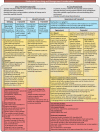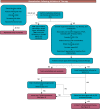Management of Pulmonary Arterial Hypertension
- PMID: 33224405
- PMCID: PMC7671829
- DOI: 10.1007/s12170-020-00663-3
Management of Pulmonary Arterial Hypertension
Abstract
Purpose of review: This review focuses on the therapeutic management and individualized approach to Group 1 pulmonary arterial hypertension (PAH), utilizing Food and Drug Administration-approved PAH-specific therapies and various interventional and surgical options for PAH.
Recent findings: The paradigm for the optimal management of PAH has shifted in recent years. Upfront combination therapy with an endothelin receptor antagonist and a phosphodiesterase 5 inhibitor is now widely accepted as standard of care. In addition, there is increasing emphasis on starting prostanoids early in order to delay time to clinical worsening. However, less is known regarding which prostanoid agent to initiate and the optimum time to do so. In order to facilitate shared decision-making, there is an increasing need for decision tools based on guidelines and collective clinical experiences to navigate between pharmacologic and interventional treatments, as well as explore innovative, therapeutic pathways for PAH.
Summary: The management of PAH has become increasingly complex. With a growing number of PAH-specific therapies, intimate knowledge of the therapeutics and the potential barriers to adherence are integral to providing optimal care for this high-risk patient population. While current PAH-specific therapies largely mediate their effects through pulmonary vasodilation, ongoing research efforts are focused on ways to disrupt the mechanisms leading to pulmonary vascular remodeling. By targeting aberrations identified in the metabolism and proliferative state of pulmonary vascular cells, novel PAH treatment pathways may be just on the horizon.
Keywords: Pharmacology; Prostacyclin; Prostaglandin; Pulmonary hypertension; Right heart failure; Therapeutics.
© Springer Science+Business Media, LLC, part of Springer Nature 2020.
Conflict of interest statement
Conflict of InterestIrene Pan, John Dechand, Josh Jacobs, Tara Jones, Stephen McKellar, Emily Beck and Nathan Hatton declare that they have no conflict of interest. John Ryan has received speaker honorarium from Janssen and Bayer and has provided consulting services for Janssen and Bayer. Jennalyn Mayeux has received speaker honorarium from Janssen and has participated in an advisory board for Bayer.
Figures




References
-
- Maron BA, Ryan JJ. A concerning trend for patients with pulmonary hypertension in the era of evidence-based medicine. Circulation. 2019;139(16):1861–1864. - PubMed
-
- Humbert M, Morrell NW, Archer SL, Stenmark KR, MacLean MR, Lang IM, et al. Cellular and molecular pathobiology of pulmonary arterial hypertension. J Am Coll Cardiol. 2004;43(12 Suppl S):13S–24S. - PubMed
-
- Medarov BI, Judson MA. The role of calcium channel blockers for the treatment of pulmonary arterial hypertension: how much do we actually know and how could they be positioned today? Respir Med. 2015;109(5):557–564. - PubMed
Publication types
LinkOut - more resources
Full Text Sources
Research Materials
